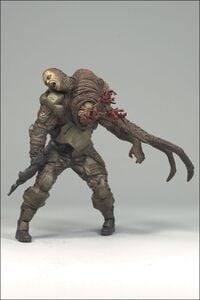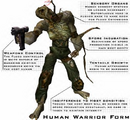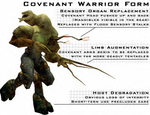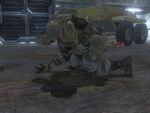Flood combat form
From Halopedia, the Halo wiki
| This article does not have enough inline citations and/or does not adhere to the proper citation format. You can help Halopedia by adding citations. |
| This article does not meet the grammar standards of Halopedia. Please repair this article so that it meets our standard. |
Template:Flood Species Infobox A Flood Combat Form[1] is an organism deemed suitable for combat that has been infected by the Flood parasite via an Infection Form or Flood Spores. The victim is mutated into a combat unit for use by the Flood. While not dangerous alone or feral, under the control of a Gravemind, they can be coordinated and deadly.
Pathology
A Combat Form is not a natural organism, but rather a mutated host infected by parasitic Flood Super Cells implanted by an Infection Form. Successful creation of a Combat Form requires a host with sufficient biomass and calcium store, and an infection form to infect the host. After mutation begins, the infection form attaches with one of its tentacles, which it uses to establish a neural connection that allows it to command the host's nervous system, thus rendering command of the legs and arms useless. During the infection process, the host's internal organs are liquefied and the nutrients from them are used to develop the tentacles and other appendages.
The host stays alive during and after the transformation process and can be conscious and aware even after the final transformation. The victim is kept alive after infection so that more of the host can be consumed by the Infection Form. This process is presumably very painful and terrifying. Once fully transformed, the Infection Form has total control over the host's body and changes the physical appearance of the host to better suit its own needs (although an infected host will be roughly the same size as it was before). On rare occasions, this effect may be weakened by time in stasis, allowing the host to regain some control, as in the case of Private First Class Wallace Jenkins.[2] Combat Forms retain the host's previous attributes and so can wield weapons, and drive and board enemy vehicles. However, Infection Forms do not require their hosts to still be alive for infection. Even dead hosts are suitable for conversion into a Combat Form, reanimating them again after infecting them; though the brain tissue remains dead, the victim's biomass and calcium reserves are sufficient to warrant infection.
In the initial stage of a Flood outbreak, the Feral Stage, Combat Forms communicate using pheromones and have one instinctual behavior; to secure new hosts to strengthen the local controlling intelligence. Once a sufficient store of biomass is available the Flood enters the Coordinated Stage, and begins forming Pure Form Flood, with the Combat Forms being used either as defensive units or calcium/biomass reserves. According to John-117, a Sangheili Combat Form looked like a Sangheili, except it appeared that someone had "killed him, buried the body, and dug it up two weeks later".[3] Flood infection is a rapid and efficient biological process, as it can take under a minute in certain cases. The Flood can recognize if a potential host is immune, and will focus on removal of that organism above all other threats in the area.[citation needed] A group of Flood will occasionally go after Sentinels if they are perceived to be the greatest threat in the area, although they are unable to be infected by the Flood due to their robotic and thus inorganic nature.
Types of Combat Forms
A specific creature is needed for the infection and creation of a Combat Form. Of the various Covenant races, only a few species meet the necessary requirements. Species known to be immune to conversion include the Mgalekgolo/Lekgolo, whose complete lack of skeletal calcium (i.e. bones) and central nervous system, colonial physiology, and insuficient biomass per individual worm make infection and neural synchronization impossible for Infection Forms, the Yanme'e, whose exoskeleton lacks the required amount of calcium which renders infection impossible, and the Huragok which is an artificial, gas-based organism, and therefore believed to be immune. Even though the above species are immune to conversion into combat forms, they are still probably used for extra biomass.
All victims of the Flood's infection, regardless of their physiology, will undergo the reanimation process where the hosts will experience its skin decaying rapidly (if they were infected while alive), growing whip-like appendages which will serve as their primary melee weapon in close-combat situation and have their heads (which are useless to the Infection Form, as it is now doing any and all neural work) pushed aside/apart to provide space for the Infection Form to rest itself on the host' chest. In Halo 3, the reanimation process can be witnessed; the host will twitch around in pain, and eventually collapse on the ground. Afterward, the whip appendages will force itself out of host's left arm, and the Infection Form will force itself out of the host's chest.
If available, the Combat Forms are able wield the arsenals of the UNSC and those of the Covenant. In Halo 2, all Combat Forms are also capable of driving and boarding vehicles and are able to do so in Halo 3, though the ability to drive vehicles is lost. They still retain the ability to board slow moving vehicles however.
Human Form
The Human Combat Form is significantly smaller than other forms due to their original smaller size. As with other Combat Forms, it is capable of sustaining massive physical damage before being unusable to the Flood controller; in fact, as long as the chest cavity and legs remain intact, it will continue to fight. Although it cannot take as much damage as the Sangheili Combat Form can, the Human Form has some advantages.
It seems to be more alert and is quicker to melee an opponent. It also presents a smaller, harder target to hit, especially the Infection Form, as it isn't protruding out of the body as much as those of Sangheili Forms. However, in Halo 3, the Human form becomes an easier target to hit; the Infection Form protrudes a lot more out of the host's chest and becomes a visibly significant target, and it seems to be significantly slower.
Sangheili (Elite) Form
The Sangheili Combat Form is a formidable enemy as it is very agile, resilient, and capable of utilizing its host's armor abilities such as Active Camouflage and Energy Shields to assist them in combat. The Sangheili Combat Forms are slightly larger than the Human Form and as such present a larger target.
In Halo 2, all of the Sangheili Forms encountered use one armor palette; the Minor Domo's Combat Harness. In Halo 3 however, the Sangheili Forms will retain its host's armor palette. Strength of each Sangheili Form will be dependant on the ranks of its host; an infected Sangheili Major will be considerably harder to kill than a Sangheili Minor.
Jiralhanae (Brute) Form
The Jiralhanae Combat Form, is a formidable enemy and is more aggressive in combat than other Combat Forms, as it will charge towards an opponent recklessly; this behavior is most likely as a result of the Jiralhanae's savage nature, and favor of close combat.
The Jiralhanae Form is more powerful than the Human Form, but falls short against the Sangheili Form. It is bulkier and slower than other Combat Forms. Since the reanimation process strips the host of their damaged Jiralhanae Power Armor, the Jiralhanae Form cannot make use of their host's armor abilities.
Unggoy (Grunt) and Kig-yar (Jackal) Combat Forms
These forms do not appear in the trilogy and are instead introduced in Halo Wars.[notes 1] Rarely seen in actual combat situations, infected Unggoy and Kig-yar are more commonly converted into Carrier Forms or processed for their biomass. These "building blocks" can be used to add to a Gravemind's superstructure or be molded into Flood Pure Forms.
Unggoy and Kig-yar Combat Forms have only been witnessed in the first recorded contact between the Covenant and the Flood. It is possible that these weaker forms were quickly ruled out by the Flood and determined to be a less efficient use of biomass after only just a few battles. They are weaker, slower, and easier to kill than their Sangheili Combat Form brethren.
Anti-Flood Countermeasures
Combat Forms can take extensive and sizeable amounts of damage before being neutralized. Arms, legs and even heads can be dismembered before they are incapacitated. The weak areas of a Combat Form are its sensory appendages that normally develop on the upper chest. This is where the Infection Form has nestled, and the body is incapacitated if this area is destroyed by a projectile weapon.
In all three Halo games, a Combat Form may fall only to stand up again and keep fighting. This can only happen if it still has a usable limb and appendage. In Halo 2 and Halo 3, if the body is not destroyed, Combat Forms can be revived if another Infection Form crawls into it.
Human weapons are generally more effective against the Flood, as Covenant plasma weaponry is designed to debilitate targets by causing burning pain and structural damage to bodies, and the Flood cannot feel pain or be crippled.[4] However, In Halo 3, plasma-based weaponry and melee attacks, formerly weak against the Combat Forms in the previous two games, are now highly effective. Piercing weapons such as the Sniper Rifle and the Beam Rifle have little effect on Combat Forms. At a distance, explosive ordnance such as grenades and ranged weapons such as the Battle Rifle or the Covenant Carbine can perform well against Combat Forms. Do note that Plasma and Spike grenades should be used with caution, as the Combat Form will sometimes ignore all other targets and charge players using such weapons at high speed. The Needler can be devastating, as the supercombine explosion will prevent it coming back to life in Halo: Combat Evolved, and will shatter it in Halo 2 and 3. In addition, the Needler's explosions will destroy an entire horde of charging Flood Combat Forms, similar to grenades and rocket launchers. For ranged weapons, it is recommended for players to focus their fire at the sensory appendages that are visible on Combat Forms as successfully firing at one will immediately bring down a Combat Form. Dismemberment with ranged weapons is also recommended to prevent Combat Forms from firing their held weapons. At close combat, it is recommended that individuals acquire close-quarters weapons such as the Shotgun, Energy Sword and Gravity Hammer as they perform exceptionally well against Combat Forms. Burning Combat Forms with sufficient amounts of heat is one of the most effective methods in any situation, as is the destruction of the torso. Automatic weapons are also effective.
Trivia
General
- In Halo: Combat Evolved Combat Forms will not disintegrate from successive melee hits when they are dead like in Halo 2 and Halo 3.
- Flood Combat Forms seem to take on physiological and biological changes throughout the Halo trilogy; these changes from game to game could be due to the Gravemind's influence in attempting to create a better Flood soldier or they could simply be graphical updates.
- Human flood forms always seem to have a screaming human face when infected.
- Some Elite flood combat forms still have shields.
Halo: Combat Evolved
- In all of the Halo games, Flood Combat Forms always hold the Shotgun with one hand, and fire it without pumping another round into the chamber. They somehow manage to make the shotgun pump itself. A possible explanation for this is that the Flood has extended an appendage into/onto the Shotgun which allows it to use the Shotgun's pump as a body part, or the pump action just wasn't programmed into Halo: Combat Evolved.
- In Halo: Combat Evolved if you stand on a Light Bridge (343 Guilty Spark) and shoot off armed Combat Forms' gun arms, they will leap onto the bridge and get stuck and will only be able to move by jumping at you.
- If you shoot both arms off a Combat Form in Halo: Combat Evolved it will not be able to attack you and will simply follow you around. Players have dubbed this instance as creating a "Flood Buddy".
- This is the only game in which an Infection Form cannot revive a dead Combat Form; instead they may just get back up.
- In Halo: Combat Evolved all human combat forms are bare foot for some reason. The reason for this remains unknown however it is not present in Halo 2 and Halo 3.
Halo 2
- Halo 2 is the only game where the Flood are able to drive vehicles.[5]
- When using the Grunt Birthday Party skull against the Flood in Halo 2, the effect of the skull will cause the plasma grenade explosion to occur when you shoot the Combat Form in the chest, where the Infection Form is.
- Reflecting their enhanced intelligence, human combat forms still wear the armor they had on when they first transformed making it signifigantly harder to shoot the infection form in their chest. Elite forms can now also have shields which recharge over time. Once the shield is taken, though, they are very easy to incapacitate.
Halo 3
- The Combat Form can pick up any weapon should it be near them when they "resurrect". They will also pick up two handed weapons such as the Plasma Cannon and Flamethrower if close by. Like other weapons, they will wield it with only one hand.
- The Combat Form's performance in CQC is inferior compared to Halo 2. They can't operate or jack vehicles, and don't have the ability to sprint or berserk.
- Probably to prevent the player from getting a big combat advantage from Jiralhanae combat forms during the brief time they are allies in The Covenant (Level) or perhaps to prevent enemy Flood combat forms from overwhelming the player, weapons that would normally be picked up when a Jiralhanae combat form "resurrects" are deleted by the game's code, rendering them unusable.
- An infected Jiralhanae Chieftain will turn into the generic Jiralhanae Combat Form character model, which is used for all Jiralhanae that become infected, regardless of rank or armor type. This is a pattern shown throughout the games; Combat Forms are all portrayed with a singular generic character model, depending on the species that is infected.
- Regardless of gender, an infected Human Flood becomes a male Combat Form. There are no variations between an infected male or female Marine, because there is only one character model for a Human Combat Form in the game.
Gallery
- FloodWeaponless05.jpg
A Sangheili Combat Form from Halo 2.
- Combat forrn HGN.jpg
Two Human Combat Forms in Halo Graphic Novels's Breaking Quarantine.
- 1216929149 Flood Combat Form (Very Angry).jpg
A Sangheili Combat Form in Halo: Graphic Novel.
- Flood base-marine-copy-1-.jpg
Human Combat Form as depicted on the Halo Wars: Official Strategy Guide.
- FloodFaces-large.jpg
A Jiralhanae Combat Form and a Human Combat Form in Halo 3.
Notes
- ^ While no canon source ever denied it was possible for Grunts or Jackals to be converted, it was thought that they were unsuitable for conversion due to their small size and an assumed lack of sufficient calcium stores. Instead of using Grunts and Jackals as Combat Forms, the Flood typically used them as a type of 'nucleus' that a Carrier Form would grow around. The two species had originally been intended by Bungie to become Combat Forms, but limitations in resources and staff at the time of the formative years of the franchise led to the introduction into the fiction of the Unggoy's and Kig-yar's unsuitable status as Combat Forms. They would also serve as building blocks for a Gravemind. It wasn't until the release of Halo Wars that they were formally implemented in-game.
Sources
- ^ Halo: The Flood, page 225: "The first of these combat forms he'd seen had once been Elites."
- ^ Halo: The Flood, page ??
- ^ Halo: The Flood, page 220
- ^ Halo: Evolutions - Essential Tales of the Halo Universe - The Mona Lisa
- ^ Halo 2, Template:Levelname
| |||||||||||||||||||||||||||||||||



